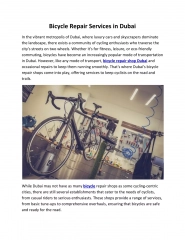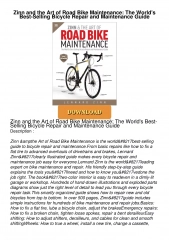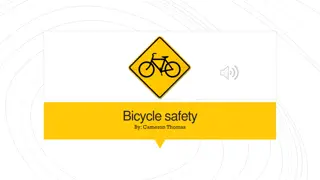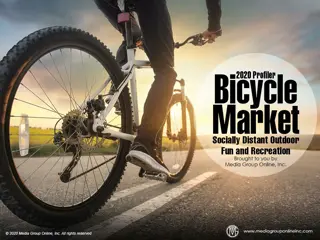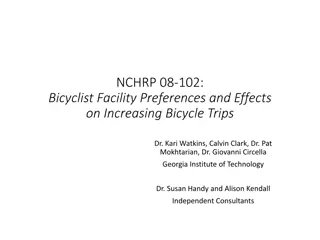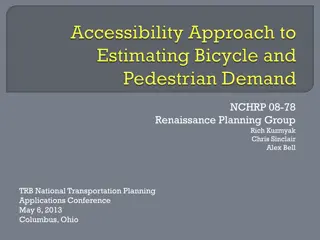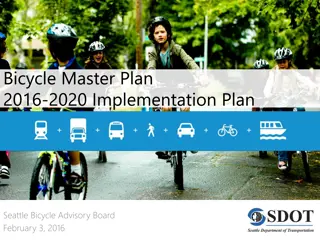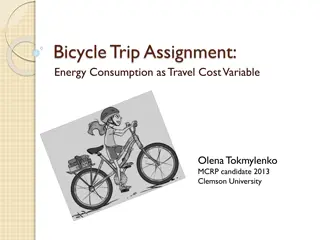Changing Trends in the Bicycle Industry: An Overview
The bicycle industry has seen shifts in consumer behavior, with a decrease in independent bike shop sales but an increase in per-store revenue. Certain product categories, like e-bikes and specific types of bicycles, have shown growth while traditional bike sales have declined. Despite a decrease in overall participation, niche markets like high-tech bikes and bike-sharing are gaining traction. Some retailers are adapting by focusing on services rather than products. These changes reflect a dynamic landscape influenced by factors such as e-commerce and shifting consumer preferences.
Download Presentation

Please find below an Image/Link to download the presentation.
The content on the website is provided AS IS for your information and personal use only. It may not be sold, licensed, or shared on other websites without obtaining consent from the author.If you encounter any issues during the download, it is possible that the publisher has removed the file from their server.
You are allowed to download the files provided on this website for personal or commercial use, subject to the condition that they are used lawfully. All files are the property of their respective owners.
The content on the website is provided AS IS for your information and personal use only. It may not be sold, licensed, or shared on other websites without obtaining consent from the author.
E N D
Presentation Transcript
Pedaling Up a Steep Grade o According to The NPD Group, total 2017 retail sales at independent bike shops were $3 billion, a 1% decrease from 2016. This is approximately half of the total sales of all cycle products, which was $5.9 billion, which decreased 3.0% from 2016. o According to the National Bicycle Dealers Association s latest research (2016), the number of independent bicycle retailers decreased 2.6% to 3,700, which is 90 fewer shops than the end of 2015 and 550 fewer since 2010. o Although the number of shops continues to decrease, 2016 per-store revenue increased 17%, from $916,000 to $1,068,000.
Some Product Categories Lead the Pack o The Bicycle Product Suppliers Association reported the total value of bicycles shipped during 2017 decreased 1%, or $15 million. Unit shipments decreased 4%, or 90,875 units fewer. o According to Bicycle Retailer, only 6 product categories generated sales increases: BMX, 29er front-suspension, 27.5 full-suspension, e-bikes, gravel and 24 bikes; all other categories decreased. o Competition from e-commerce, both third-party sellers, such as Amazon, and bicycle manufacturers that are now selling direct to consumers, has negatively impacted sales at independent bicycle dealers.
Bicyclist Behavior o Although bicycling (road, mountain and BMX, specifically) continued to be second in outdoor activities among Americans aged 6 24 during 2016, the number of people participating decreased from 19.9 million to 18.2 million. Outings dropped 24% to 58. o In a more inclusive study, the National Sporting Goods Association found the number of participants age 7+ who had ridden a bike 6 or more days per year increased 0.5% to 36.2 million riders during 2016. o Youth participation, ages 7 17, decreased 0.7%, while adult participation increased 1%. Adult female participation decreased 2.6% and male adult participation increased 2.8%. Adult participation has been flat since 2000 and youth has decreased significantly.
High-Tech Bikes o E-bikes are an emerging trend in the US, although they have been popular and encouraged by cities in Europe since at least 2014. Some US cities, such as New York, have banned e-bikes because of concerns about reckless riding through city streets. o Data from eCycleElectric Consultants shows approximately 34 million e-bikes were sold worldwide, mostly in China and Europe, with 263,000 sold in the US during 2017, a 25% increase. o Bike-sharing is another trend occurring in cities. During 2016, bike-sharing accounted for 28 million rides in 50 US cities. New technology allows dockless bike-sharing, where customers find and unlock bicycles with a smartphone app.
Shifting the Market into Another Gear o Some independent bicycle dealers have found success shifting to a service model rather than a product model. They focus on assembling, fixing and repairing bicycles and selling bike accessories, such as helmets and replacement tires. o Research from The NPD Group found outdoor gear sales decreased by 6% during 2017, due to Millennials who prefer moderately priced items. Most bike stores stock specialized premium bikes for enthusiasts instead of average-priced bikes for a wider market. o Bicycle dealers can capitalize on consumers interest in eco-consciousness while also addressing older customers health issues by carrying more e-bikes.
Advertising Strategies o Promote e-bikes to Baby Boomers and Gen X as an easier way to incorporate exercise into their routines. o Invite local, independent bike retailers to be co-sponsors of station-sponsored and/or - promoted fundraising events with bicycle runs. o Promote a service to assemble bicycles purchased online or at big box stores.
New Media Strategies o Offer a premium bicycle repair pick-up-and-delivery service via online scheduling on your Website. o Refurbish used bikes. Paint them with whimsical patterns, add baskets and decorations and post photos on Instagram and Pinterest to appeal to Millennials. Let prospective customers bid on them. o Work with local environmental groups and your local city or county government to promote bike- sharing on Facebook and their Websites.


